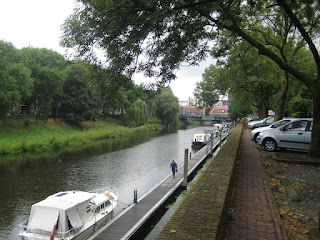When Margaret joined us we decided to backtrack as I needed to go back to Utrecht to have my ankle checked.
It rained very heavily all Sunday and we were in the town called s’-Hertogenbosch (Duke’s Wood) shortened to Den Bosch. The town received city rights in 1185 and built a fortified wall around the town. Moats were built on the two small rivers which flowed either side of the town then in the 14th century the second city wall was built which meant the river branches were enclosed in the city and the waterways were called the Binnendeize. The town harbour lies alongside the outer town wall.

On Monday, Margaret arrived from Australia to visit us, it was a convenient place to meet as the train from Schipol takes about 90 minutes and cost 14 euro.
In Den Bosch we took a cruise on the Binnendieze in small boats which took us along the old canal system through and under the town. It was a fantastic cruise which you must take when you come to Den Bosch.
In the 1500’s it was forbidden to build outside the city all so as the population increased people started to build across the water hence the tunnels and bridges. In 1964 the city council decided to close the 12 kilometres of waterways inside the town walls but fortunately a group of people recognised the historical value and prevented a total closure. In 1973 restoration started which took 25 years and a huge cost and now 3.5 kilometres remain of which 1/3 is covered and flows under the houses and the central city buildings.
The boat trips are organised by the Binnendeize Foundation and run by volunteers.








HEUSDEN
We decided to take a trip to Heusden by bus as we would be passing it by when we leave here and our first visit was just overnight. The bus arrives on the outskirts of Heusden and we had a lovely walk through the town taking our time wandering through the small streets.
We really like the plaques above the doors which represent either the profession or philosophy of the original or the new owners.


The town hall had a model of Heusden which is typical of the walled fortified towns. The new suburbs are located on the outside of the town. The model shows the tiny town harbour on the lower right.
We had a wine on the terrace of the harbour restaurant
but decided on the Pannekoeken Restaurant for lunch as it looked like rain. Right across from us was the restaurant ‘In den Verdwaalde Koogel’ which takes its name from a cannon ball lodged in the wall, a remnant from the French occupation in 1794.
Then it was back to the bus and on the way we couldn’t resist the cherries.
Next stop
GORINCHEM
Margaret’s first experience of large barges was in our first lock.
Coming out we passed a typical dutch scene of seniors bicycling along the dike enjoying a day out.
Then it was up the canal where we passed the horses living alongside the river.
and across the Waal dodging the barges.
And into Gorinchem which we entered through the small lock into the Lingehaven which was like a matchbox after the large 240 metre long locks.

The view when the lock door opened is spectacular.
As this is our second time in Gorinchem we caught up with some of the places we wanted to visit. We went by water ferry across the Waal to see Woudrichem and the Castle Loevestein with its history from the 13th century and the Fort Vuren which together with Gorinchem make up the old fortified towns of the 17th century old and new 19th century Holland . The castle was interesting as it was mainly a defensive castle housing soldier regiments protecting Gorinchem and Woudriche from the French and the English .
The castle was interesting as it was mainly a defensive castle housing soldier regiments protecting Gorinchem and Woudriche from the French and the English .
Fort Vuren was mainly active as the New Holland Waterline defence in the 19th and 20th century and a very pleasant place to have lunch on the terrace.
Woudrichem was a lovely place to wander around looking at the plaques above the houses.

Then it was time to go back to Gorinchem to Umbrella Square in the centre of town and pursue our favourite pastime of people watching and sampling the wine of the day.

Next stop
Gouda.


No comments:
Post a Comment